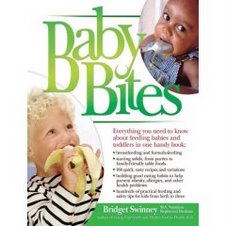
Worried about the University of Missouri Study about BpA in baby bottles? Read on for more information. This article was originally published in the Winter 2007 Feeding Kids Newsletter (http://www.nutritionforkids.com/) and should give you more insight on Bisphenol A.
A Pinch of Plastic in Your Food?
When you stop to think about it, plastic plays a big role in our lives--particularly in food storage and preparation. The question is--is it safe to have so much of our food in contact with plastic? The short answer is yes--but it depends-- on what type of plastic, what type of food and what conditions the plastic is exposed to.
What's In Plastic?
Specific chemicals are added to plastic to give them the properties that make them so useful--hard, soft, flexible, or stretchable. Over the last 10 years, the safety of some of these chemicals has been called into question, especially since under some conditions, the plastic can leach into food.
Phthalates and adipates belong to a group of chemicals called "plasticizers" --they help soften plastics into flexible forms and are found in polyvinyl chloride plastic (PVC) and some cling wraps. So common are phthalates in the environment, it's difficult not to come into contact with them at home; they're found in nail polish, 5 gallon water bottles, cosmetics, fragrance in detergents and cleansers, adhesives, inks and vinyl shower curtains. Bisphenol A (BPA) is an industrial chemical used in plastic to make it clear and shatter resistant. It is also used in the epoxy linings of food cans, dental sealants, CD's and DVD's. Its use is widespread-- in 2003 close to 2 billion pounds were used for plastic and resins that come in contact with food.
What's the Problem?
Phthalates and BPA are considered "hormone" or endocrine disruptors" because when present in large enough amounts, they mimic hormones in the body, which can affect many organs and systems including the reproductive system. Steven G. Hentges, Ph.D., Executive Director, Polycarbonate/BPA Global Group at the American Chemistry Council says, "As a general rule, the amount of any substance leaching from a plastic can increase with longer time and higher temperatures."
The Government Says:
• The Center for the Evaluation of Risks to Human Reproduction, a division of the National Toxicology Program of the US Department of Health and Human Services says in a draft report there is "some concern that exposure to BPA causes neural and behavioral effects to fetuses, infants and children."
• Current levels of seven phthalates studied by the National Institute of Environmental Health Sciences posed "minimal" concern for causing reproductive effects. However, the National Toxicology Program concluded that high levels of one phthalate, Di-n-butyl phthalate, may adversely affect human reproduction or development.
American Chemistry Council spokesperson Steven Hentges Says :
Bisphenol A has been comprehensively evaluated by government bodies around the world. All support the conclusion that bisphenol A is not a risk to human health, in particular at the very low levels to which people could be exposed from use of consumer products.
The Inter-Industry Group for Light Metal Packaging Says :
Human exposures to BPA from use of protective liners for food cans is exceedingly low, hundreds or more times lower than safe exposure levels set by U.S. and international regulatory agencies.
The safety of BPA-derived protective coatings in food and beverage containers have undergone independent reviews of the science by multiple regulatory agencies, including the US Food and Drug Administration, The United Kingdom Food Standards Agency, the Research Center for Chemical Risk Management of the National Institute for Advanced Industrial Science and Technology of Japan and most recently the European Food Safety Authority. Every regulatory review conducted to date has affirmed that BPA based can liners are approved for use in food contact applications and safe for use.
The Bottom Line:
Animal studies and some human studies have shown possible harmful effects of some plastic-bound chemicals that can migrate into food. Experts on both side of the issue agree that most of us ingest microscopic amounts of chemicals from plastic in food and the environment. The difference of opinion is in what "reference dose" is actually safe. While industry officials stand by current regulatory standards, the Environmental Working Group and other consumer interest groups advocate for lowering the level of what is allowed in contact with food.
Until there is enough evidence for a conclusion, you can use common sense and a bit of caution especially for the pregnant women, infants and young children. That's because tiny amounts of any chemical during critical development of organ systems could have long ranging effects, especially on reproductive systems.
Practical Info:
Regarding use of plastics with food, these are things you can do to keep that pinch of plastic out of your food:
Because plastics can leach small amount of chemicals into food when heated, watch what plastics you use in the microwave:
*Don't let plastic wrap touch food during microwave cooking, or use a hard plastic cover, wax paper or white, microwave safe paper towels.
*Don't cook with any plastic that is not meant to be heated. This symbol is often imprinted on containers that are safe for the high temperatures of the microwave: However, The National Geographic Green Guide notes that this is only a guarantee that the plastic won't melt, not that chemicals won't leach into your food.
If you're not sure, use glass or lead-free ceramics, especially for foods you are actually cooking, not just reheating.
*Never use plastic grocery bags or other materials not for food use.
*Don't heat food in plastic that is meant for one-time use (frozen dinner containers) or that is not labeled as safe for the microwave. (Margarine tubs, yogurt containers, Styrofoam to-go boxes.)
*When plastic shows signs of age--turning cloudy, cracked or otherwise well used, many experts recommend discarding it. However, the American Chemistry Council notes that it's somewhat of a myth that cloudiness indicates plastic is degrading. (Another urban legend regarding freezing plastic bottles is also untrue--you can freeze plastic water bottles!)
Because chemicals are more likely to leach out when in contact with high fat foods, follow these tips:
*Remove deli foods from plastic wrapping from the grocery store.
*If possible, buy oil in glass or metal bottles. Or make sure the plastic bottle is one recommended below.
*For the processed foods you do buy, get them in a variety of packaging--canned, paper, boxed and plastic. Keep in mind that canning as a food preservation method has a 200 year long history in regard to safe food preservation.
*Eat whole foods! As is consistent with every piece of current dietary advice --eat as many whole foods as possible--this will automatically reduce your exposure to any chemicals found in packaging.
Plastic by the Numbers:
When choosing containers you'll use over and over again, look for recycling codes, as well as abbreviation of plastic type on the bottom of the container. If there is no number, or abbreviation, call the manufacturer to find out.
According to the National Geographic Green Guide, safer plastics to use for food and water are :
#1 Polyethylene Terephthalate (PETE or PET also widely recyclable) Common products: individual water bottles, soft drink bottles and medicine containers.
#2 High Density Polyethylene-(HDPE--also widely recyclable) Common products: Toys, milk bottles, shampoo
#4 Low Density Polyethylene (LDPE) Common products: Ziploc and Glad bags, wrapping films, grocery bags, some squeezable food bottles
#5 Polypropylene (PP). Common products: Syrup bottles, yogurt tubs, diapers, some baby bottles
*Polyactide or PLA On the cutting edge of "green", this plastic is corn based, which is safe to use with food, compostable and biodegradable but does not withstand heat.
Plastics to Use More Caution With:
#3 Polyvinyl chloride (PVC) is considered one of the most toxic plastics, often a likely candidate for phthalates and adipates. Common products: meat wraps, cooking oil bottles.
#6 Polystyrene (PS) Common products: foam containers and clear disposable take out containers, plastic cups and cutlery. It may leach styrene, a possible carcinogen.
#7 Other Usually indicates Polycarbonate, which could contain BPA as well as phthalates. Polycarbonate is not used for food packaging, only for home food storage, according to Hentges.
What about Baby Bottles?
As of 2006, 95% of plastic baby bottles were made of polycarbonate. Here are alternatives and safer ways to use Polycarbonate plastic.
*In general, opaque or colored bottles are BPA free. Here are some BPA free models made out of #5 polypropylene: Medela Baby Bottles, Gerber Fashion Tint bottles, Gerber Lil' Sport Bottles and Evenflo opaque and pastel bottles are reported to be #5 plastics, which are BPA free. Born Free bottles are made of Polyamide (PA), another BPA free plastic.
*Use disposable bottle liners, made by Gerber and Playtex, which don't contain BPA.
*Don't heat formula or breast milk in Polycarbonate plastic bottles since chemicals are more likely to leach out when heated
*Use glass instead--however this option has different safety risks
Food for Thought:
We live in a world polluted with many environmental chemicals. While BPA and phthalates may be transferred in tiny amounts in food, they are also common pollutants in air, water, and can be found in everyday products like cleaning supplies, adhesives and even cosmetics.
Do what you can at home to reduce your exposure to environmental chemicals--but stronger regulations at the federal level are critical for all chemicals that could affect vulnerable populations like children and pregnant women. The reference dose for BPA was developed by the EPA in 1987, 10 years before research showing possible adverse affects of very low doses was done.
Clearly it's time for an update and it may be coming. Congressman Albert Wynn, Chairman of the Senate Subcommittee on Environment and Hazardous Materials
said in a November 9th 2007 press release: "…broadly, our chemical policies are not working. …we now know that children are especially vulnerable to toxic chemicals, even at extremely low doses. Further, these effects in children can be cumulative as they grow up. However, these sorts of relatively recent observations are not reflected in the federal laws, supporting the need to make serious revisions to our chemical policies."
Let's all advocate for stronger environmental policies for the health of our children...and theirs.
Bridget Swinney is a registered dietitian and author of Baby Bites, Eating Expectantly and Healthy Food for Healthy Kids.
THIS ARTICLE MAY BE REPRINTED WITH PERMISSION FROM THE AUTHOR; CONTACT BRIDGET: babybitesbook@gmail.com. MEDIA: For a copy of a Good Morning Texas interview where Bridget discusses the impact of environmental chemicals in a child's diet, also contact Bridget.





No comments:
Post a Comment